Performance Management Framework: A Comprehensive Analysis
VerifiedAdded on 2022/12/19
|37
|6401
|1
Report
AI Summary
This report provides a comprehensive analysis of the performance management framework, exploring key components such as Management by Objectives (MBO), review and agree processes, and 360-degree feedback. It delves into the strengths and weaknesses of cohesive versus non-cohesive teams and their application in high-performance organizations. The report examines performance management from a control theory perspective, discussing its strengths and weaknesses, and evaluates the relevance of the balanced scorecard approach for ensuring effective performance management. The analysis highlights the importance of aligning individual and organizational goals, measuring performance, and fostering a culture of continuous improvement. The report also emphasizes the critical role of team dynamics, leadership, and organizational structure in achieving optimal performance outcomes. The study utilizes figures and tables to illustrate the MBO process cycle and team cohesiveness in developing high-performance organizations.
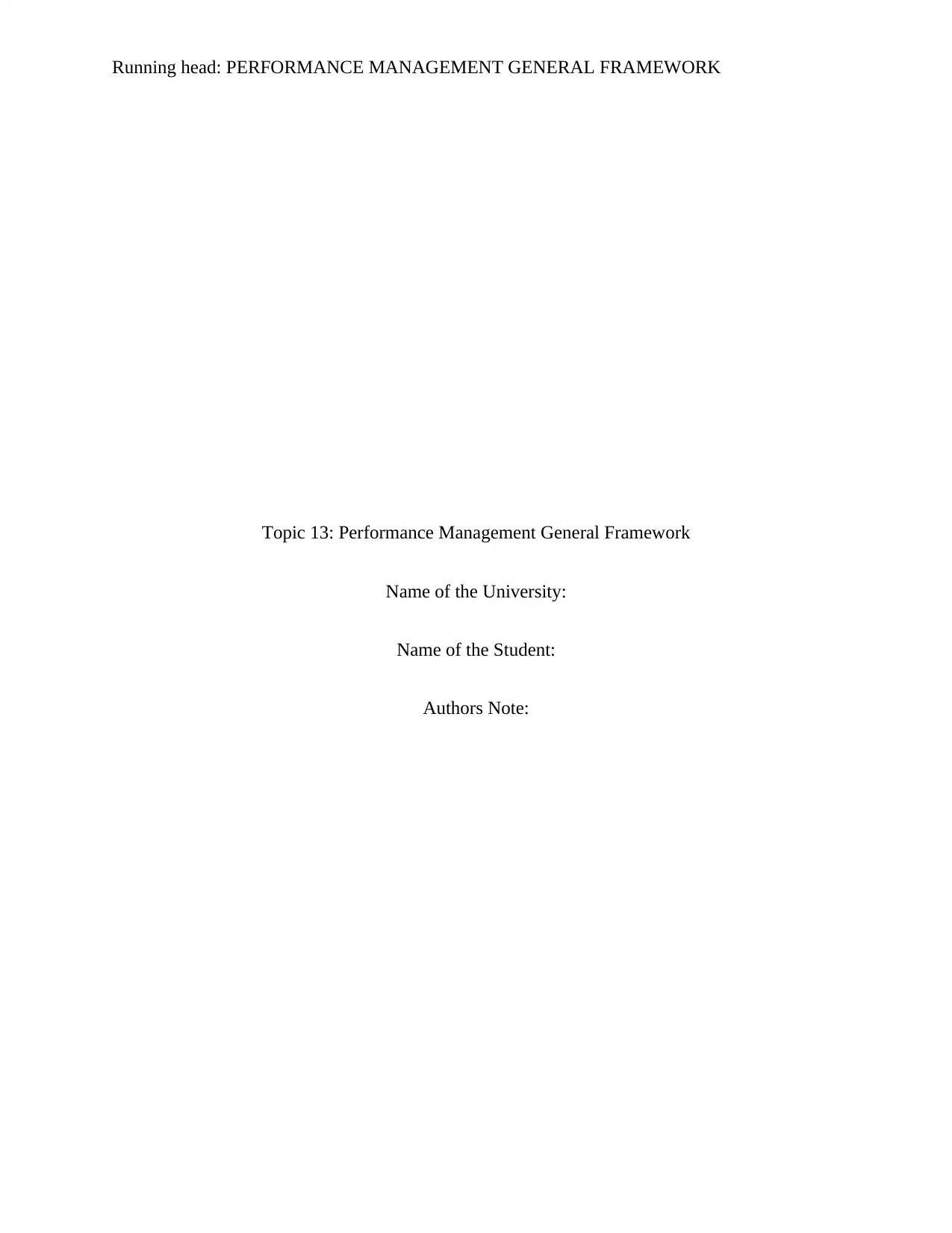
Running head: PERFORMANCE MANAGEMENT GENERAL FRAMEWORK
Topic 13: Performance Management General Framework
Name of the University:
Name of the Student:
Authors Note:
Topic 13: Performance Management General Framework
Name of the University:
Name of the Student:
Authors Note:
Paraphrase This Document
Need a fresh take? Get an instant paraphrase of this document with our AI Paraphraser
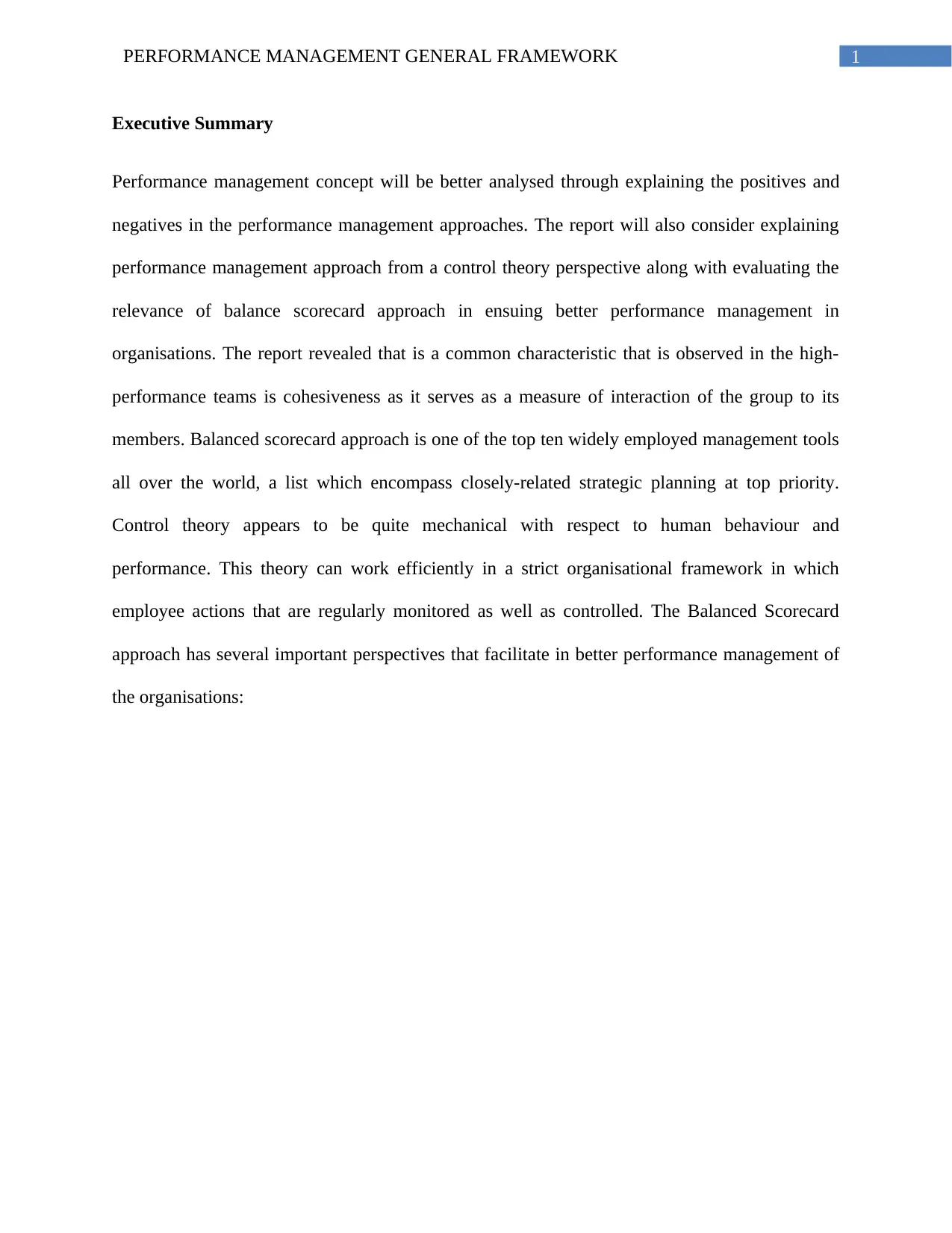
1PERFORMANCE MANAGEMENT GENERAL FRAMEWORK
Executive Summary
Performance management concept will be better analysed through explaining the positives and
negatives in the performance management approaches. The report will also consider explaining
performance management approach from a control theory perspective along with evaluating the
relevance of balance scorecard approach in ensuing better performance management in
organisations. The report revealed that is a common characteristic that is observed in the high-
performance teams is cohesiveness as it serves as a measure of interaction of the group to its
members. Balanced scorecard approach is one of the top ten widely employed management tools
all over the world, a list which encompass closely-related strategic planning at top priority.
Control theory appears to be quite mechanical with respect to human behaviour and
performance. This theory can work efficiently in a strict organisational framework in which
employee actions that are regularly monitored as well as controlled. The Balanced Scorecard
approach has several important perspectives that facilitate in better performance management of
the organisations:
Executive Summary
Performance management concept will be better analysed through explaining the positives and
negatives in the performance management approaches. The report will also consider explaining
performance management approach from a control theory perspective along with evaluating the
relevance of balance scorecard approach in ensuing better performance management in
organisations. The report revealed that is a common characteristic that is observed in the high-
performance teams is cohesiveness as it serves as a measure of interaction of the group to its
members. Balanced scorecard approach is one of the top ten widely employed management tools
all over the world, a list which encompass closely-related strategic planning at top priority.
Control theory appears to be quite mechanical with respect to human behaviour and
performance. This theory can work efficiently in a strict organisational framework in which
employee actions that are regularly monitored as well as controlled. The Balanced Scorecard
approach has several important perspectives that facilitate in better performance management of
the organisations:
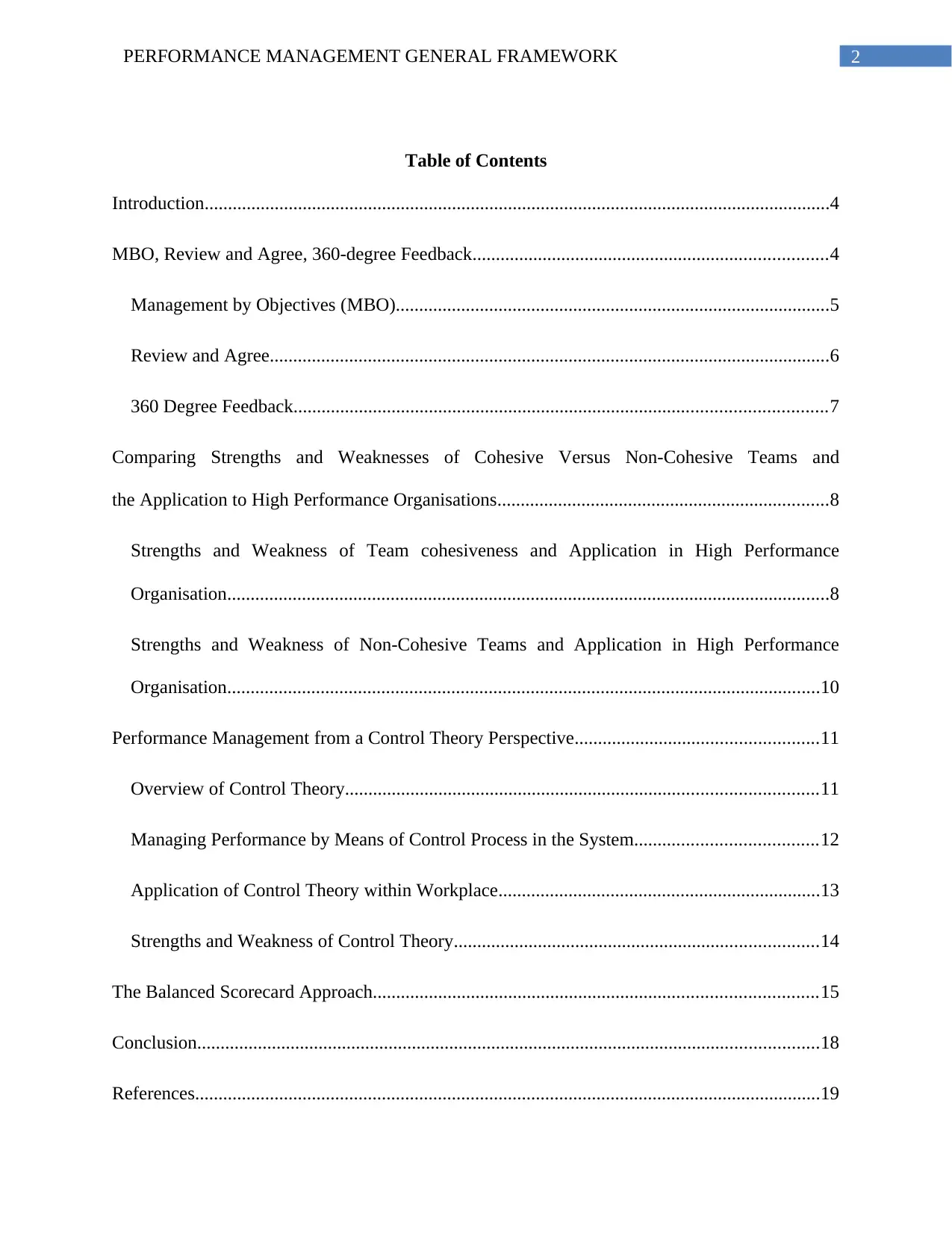
2PERFORMANCE MANAGEMENT GENERAL FRAMEWORK
Table of Contents
Introduction......................................................................................................................................4
MBO, Review and Agree, 360-degree Feedback............................................................................4
Management by Objectives (MBO).............................................................................................5
Review and Agree........................................................................................................................6
360 Degree Feedback..................................................................................................................7
Comparing Strengths and Weaknesses of Cohesive Versus Non-Cohesive Teams and
the Application to High Performance Organisations.......................................................................8
Strengths and Weakness of Team cohesiveness and Application in High Performance
Organisation.................................................................................................................................8
Strengths and Weakness of Non-Cohesive Teams and Application in High Performance
Organisation...............................................................................................................................10
Performance Management from a Control Theory Perspective....................................................11
Overview of Control Theory.....................................................................................................11
Managing Performance by Means of Control Process in the System.......................................12
Application of Control Theory within Workplace.....................................................................13
Strengths and Weakness of Control Theory..............................................................................14
The Balanced Scorecard Approach...............................................................................................15
Conclusion.....................................................................................................................................18
References......................................................................................................................................19
Table of Contents
Introduction......................................................................................................................................4
MBO, Review and Agree, 360-degree Feedback............................................................................4
Management by Objectives (MBO).............................................................................................5
Review and Agree........................................................................................................................6
360 Degree Feedback..................................................................................................................7
Comparing Strengths and Weaknesses of Cohesive Versus Non-Cohesive Teams and
the Application to High Performance Organisations.......................................................................8
Strengths and Weakness of Team cohesiveness and Application in High Performance
Organisation.................................................................................................................................8
Strengths and Weakness of Non-Cohesive Teams and Application in High Performance
Organisation...............................................................................................................................10
Performance Management from a Control Theory Perspective....................................................11
Overview of Control Theory.....................................................................................................11
Managing Performance by Means of Control Process in the System.......................................12
Application of Control Theory within Workplace.....................................................................13
Strengths and Weakness of Control Theory..............................................................................14
The Balanced Scorecard Approach...............................................................................................15
Conclusion.....................................................................................................................................18
References......................................................................................................................................19
⊘ This is a preview!⊘
Do you want full access?
Subscribe today to unlock all pages.

Trusted by 1+ million students worldwide
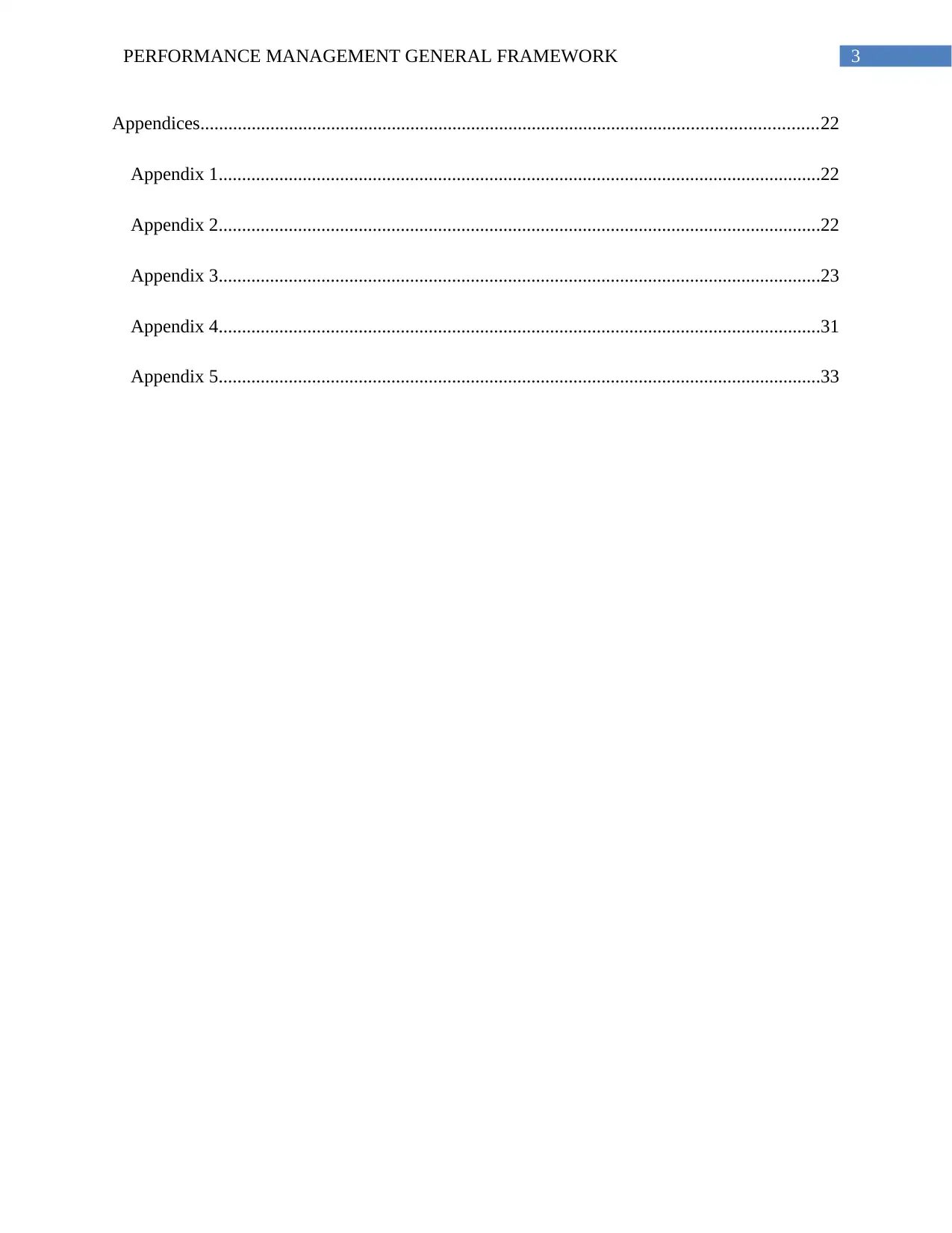
3PERFORMANCE MANAGEMENT GENERAL FRAMEWORK
Appendices....................................................................................................................................22
Appendix 1.................................................................................................................................22
Appendix 2.................................................................................................................................22
Appendix 3.................................................................................................................................23
Appendix 4.................................................................................................................................31
Appendix 5.................................................................................................................................33
Appendices....................................................................................................................................22
Appendix 1.................................................................................................................................22
Appendix 2.................................................................................................................................22
Appendix 3.................................................................................................................................23
Appendix 4.................................................................................................................................31
Appendix 5.................................................................................................................................33
Paraphrase This Document
Need a fresh take? Get an instant paraphrase of this document with our AI Paraphraser
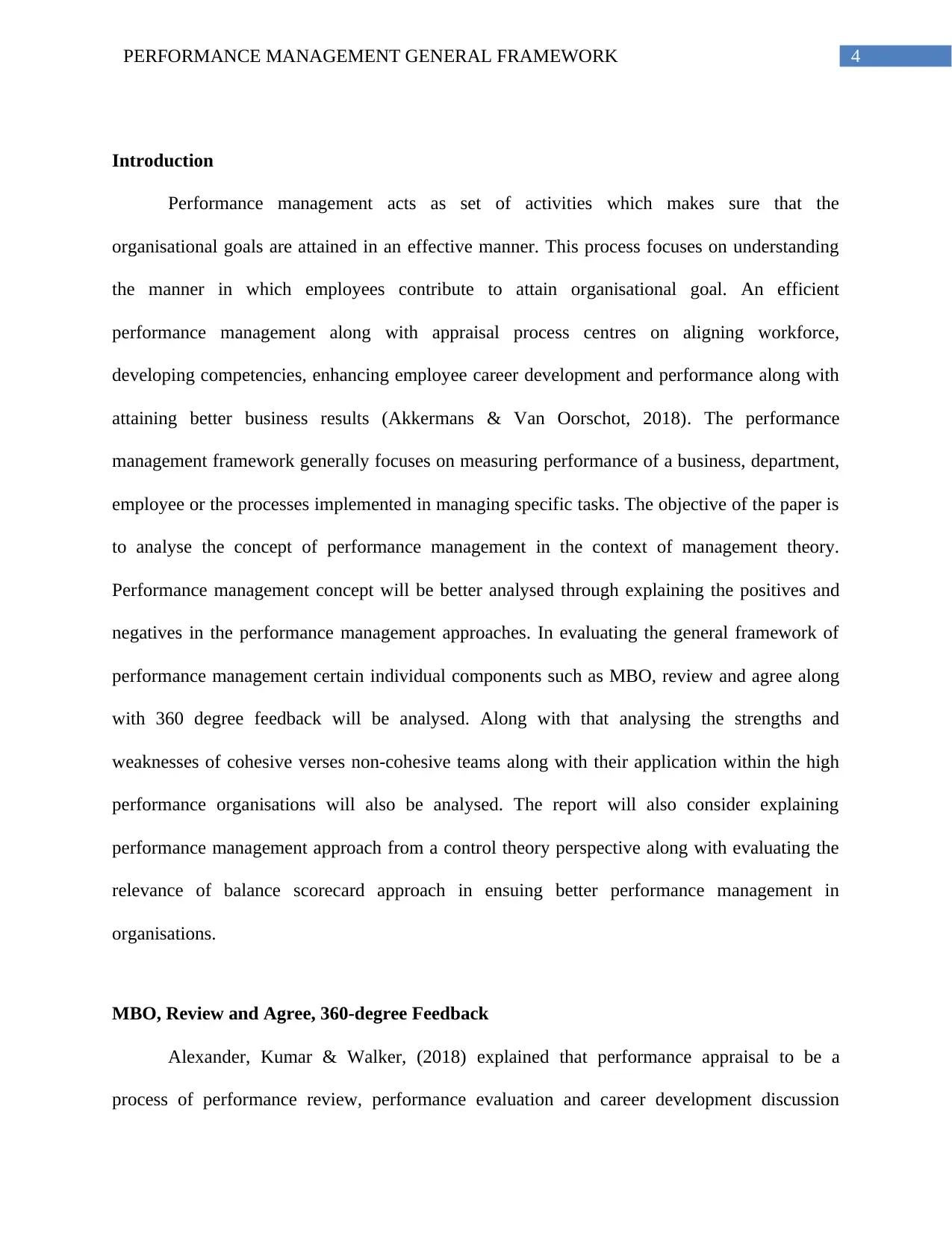
4PERFORMANCE MANAGEMENT GENERAL FRAMEWORK
Introduction
Performance management acts as set of activities which makes sure that the
organisational goals are attained in an effective manner. This process focuses on understanding
the manner in which employees contribute to attain organisational goal. An efficient
performance management along with appraisal process centres on aligning workforce,
developing competencies, enhancing employee career development and performance along with
attaining better business results (Akkermans & Van Oorschot, 2018). The performance
management framework generally focuses on measuring performance of a business, department,
employee or the processes implemented in managing specific tasks. The objective of the paper is
to analyse the concept of performance management in the context of management theory.
Performance management concept will be better analysed through explaining the positives and
negatives in the performance management approaches. In evaluating the general framework of
performance management certain individual components such as MBO, review and agree along
with 360 degree feedback will be analysed. Along with that analysing the strengths and
weaknesses of cohesive verses non-cohesive teams along with their application within the high
performance organisations will also be analysed. The report will also consider explaining
performance management approach from a control theory perspective along with evaluating the
relevance of balance scorecard approach in ensuing better performance management in
organisations.
MBO, Review and Agree, 360-degree Feedback
Alexander, Kumar & Walker, (2018) explained that performance appraisal to be a
process of performance review, performance evaluation and career development discussion
Introduction
Performance management acts as set of activities which makes sure that the
organisational goals are attained in an effective manner. This process focuses on understanding
the manner in which employees contribute to attain organisational goal. An efficient
performance management along with appraisal process centres on aligning workforce,
developing competencies, enhancing employee career development and performance along with
attaining better business results (Akkermans & Van Oorschot, 2018). The performance
management framework generally focuses on measuring performance of a business, department,
employee or the processes implemented in managing specific tasks. The objective of the paper is
to analyse the concept of performance management in the context of management theory.
Performance management concept will be better analysed through explaining the positives and
negatives in the performance management approaches. In evaluating the general framework of
performance management certain individual components such as MBO, review and agree along
with 360 degree feedback will be analysed. Along with that analysing the strengths and
weaknesses of cohesive verses non-cohesive teams along with their application within the high
performance organisations will also be analysed. The report will also consider explaining
performance management approach from a control theory perspective along with evaluating the
relevance of balance scorecard approach in ensuing better performance management in
organisations.
MBO, Review and Agree, 360-degree Feedback
Alexander, Kumar & Walker, (2018) explained that performance appraisal to be a
process of performance review, performance evaluation and career development discussion
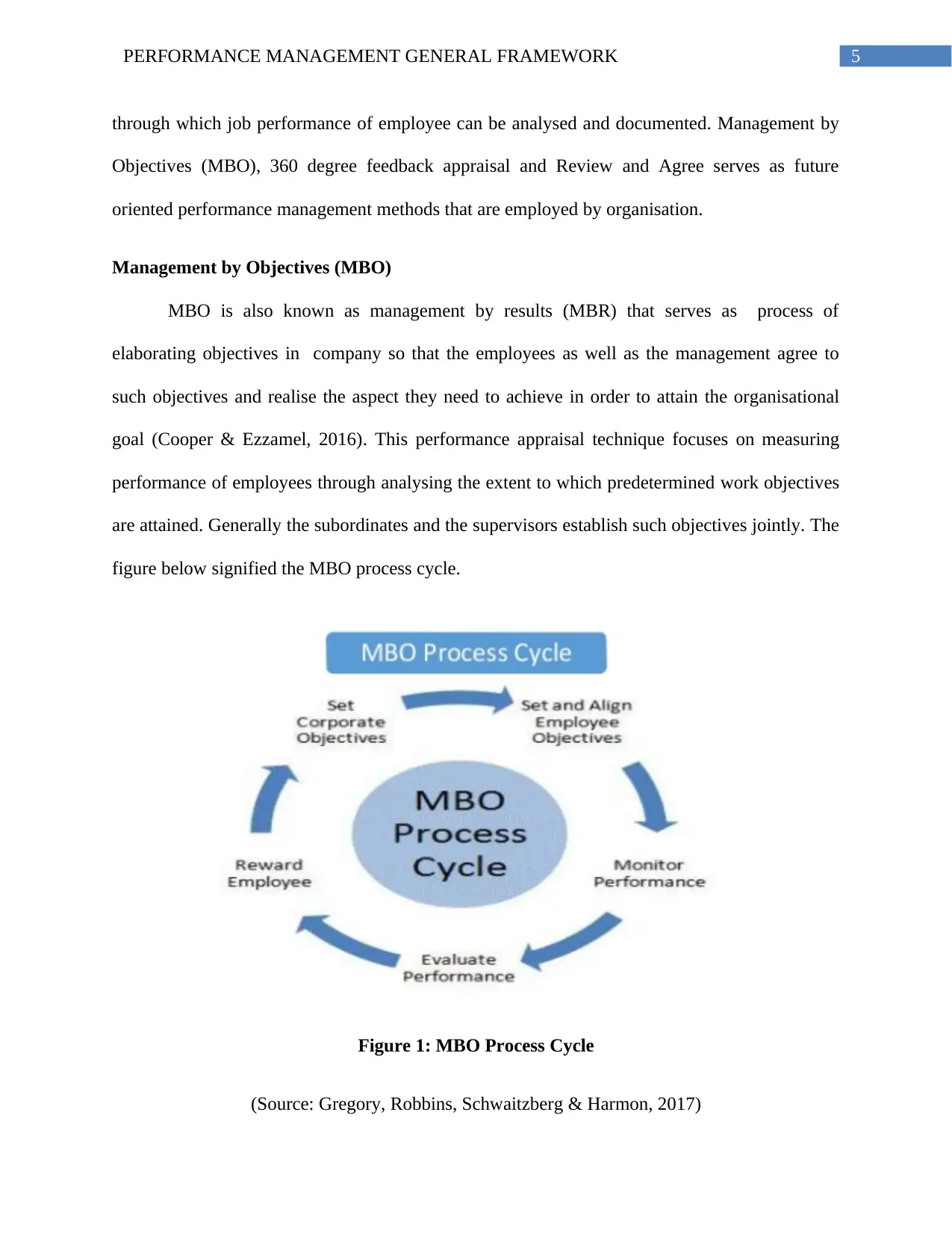
5PERFORMANCE MANAGEMENT GENERAL FRAMEWORK
through which job performance of employee can be analysed and documented. Management by
Objectives (MBO), 360 degree feedback appraisal and Review and Agree serves as future
oriented performance management methods that are employed by organisation.
Management by Objectives (MBO)
MBO is also known as management by results (MBR) that serves as process of
elaborating objectives in company so that the employees as well as the management agree to
such objectives and realise the aspect they need to achieve in order to attain the organisational
goal (Cooper & Ezzamel, 2016). This performance appraisal technique focuses on measuring
performance of employees through analysing the extent to which predetermined work objectives
are attained. Generally the subordinates and the supervisors establish such objectives jointly. The
figure below signified the MBO process cycle.
Figure 1: MBO Process Cycle
(Source: Gregory, Robbins, Schwaitzberg & Harmon, 2017)
through which job performance of employee can be analysed and documented. Management by
Objectives (MBO), 360 degree feedback appraisal and Review and Agree serves as future
oriented performance management methods that are employed by organisation.
Management by Objectives (MBO)
MBO is also known as management by results (MBR) that serves as process of
elaborating objectives in company so that the employees as well as the management agree to
such objectives and realise the aspect they need to achieve in order to attain the organisational
goal (Cooper & Ezzamel, 2016). This performance appraisal technique focuses on measuring
performance of employees through analysing the extent to which predetermined work objectives
are attained. Generally the subordinates and the supervisors establish such objectives jointly. The
figure below signified the MBO process cycle.
Figure 1: MBO Process Cycle
(Source: Gregory, Robbins, Schwaitzberg & Harmon, 2017)
⊘ This is a preview!⊘
Do you want full access?
Subscribe today to unlock all pages.

Trusted by 1+ million students worldwide
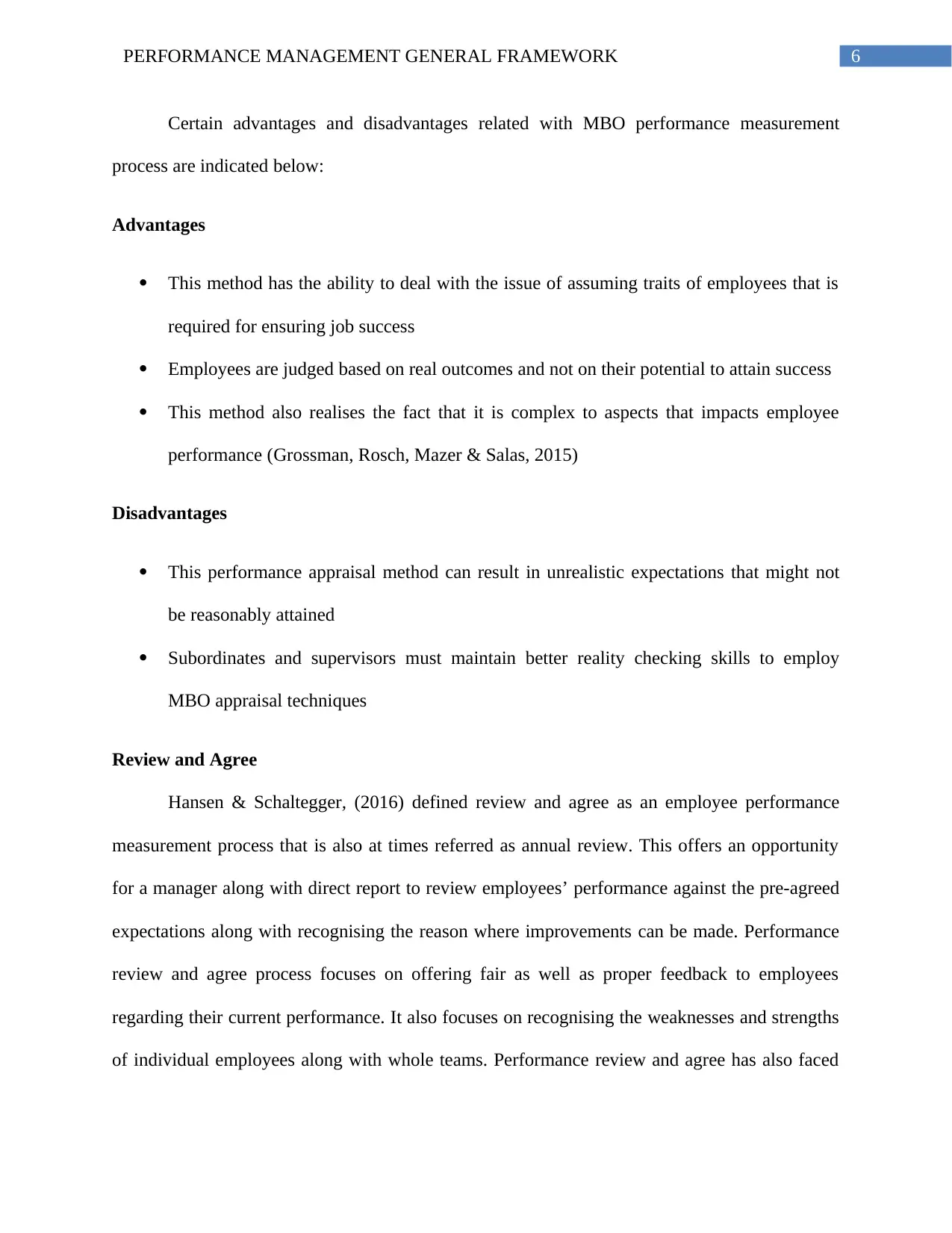
6PERFORMANCE MANAGEMENT GENERAL FRAMEWORK
Certain advantages and disadvantages related with MBO performance measurement
process are indicated below:
Advantages
This method has the ability to deal with the issue of assuming traits of employees that is
required for ensuring job success
Employees are judged based on real outcomes and not on their potential to attain success
This method also realises the fact that it is complex to aspects that impacts employee
performance (Grossman, Rosch, Mazer & Salas, 2015)
Disadvantages
This performance appraisal method can result in unrealistic expectations that might not
be reasonably attained
Subordinates and supervisors must maintain better reality checking skills to employ
MBO appraisal techniques
Review and Agree
Hansen & Schaltegger, (2016) defined review and agree as an employee performance
measurement process that is also at times referred as annual review. This offers an opportunity
for a manager along with direct report to review employees’ performance against the pre-agreed
expectations along with recognising the reason where improvements can be made. Performance
review and agree process focuses on offering fair as well as proper feedback to employees
regarding their current performance. It also focuses on recognising the weaknesses and strengths
of individual employees along with whole teams. Performance review and agree has also faced
Certain advantages and disadvantages related with MBO performance measurement
process are indicated below:
Advantages
This method has the ability to deal with the issue of assuming traits of employees that is
required for ensuring job success
Employees are judged based on real outcomes and not on their potential to attain success
This method also realises the fact that it is complex to aspects that impacts employee
performance (Grossman, Rosch, Mazer & Salas, 2015)
Disadvantages
This performance appraisal method can result in unrealistic expectations that might not
be reasonably attained
Subordinates and supervisors must maintain better reality checking skills to employ
MBO appraisal techniques
Review and Agree
Hansen & Schaltegger, (2016) defined review and agree as an employee performance
measurement process that is also at times referred as annual review. This offers an opportunity
for a manager along with direct report to review employees’ performance against the pre-agreed
expectations along with recognising the reason where improvements can be made. Performance
review and agree process focuses on offering fair as well as proper feedback to employees
regarding their current performance. It also focuses on recognising the weaknesses and strengths
of individual employees along with whole teams. Performance review and agree has also faced
Paraphrase This Document
Need a fresh take? Get an instant paraphrase of this document with our AI Paraphraser
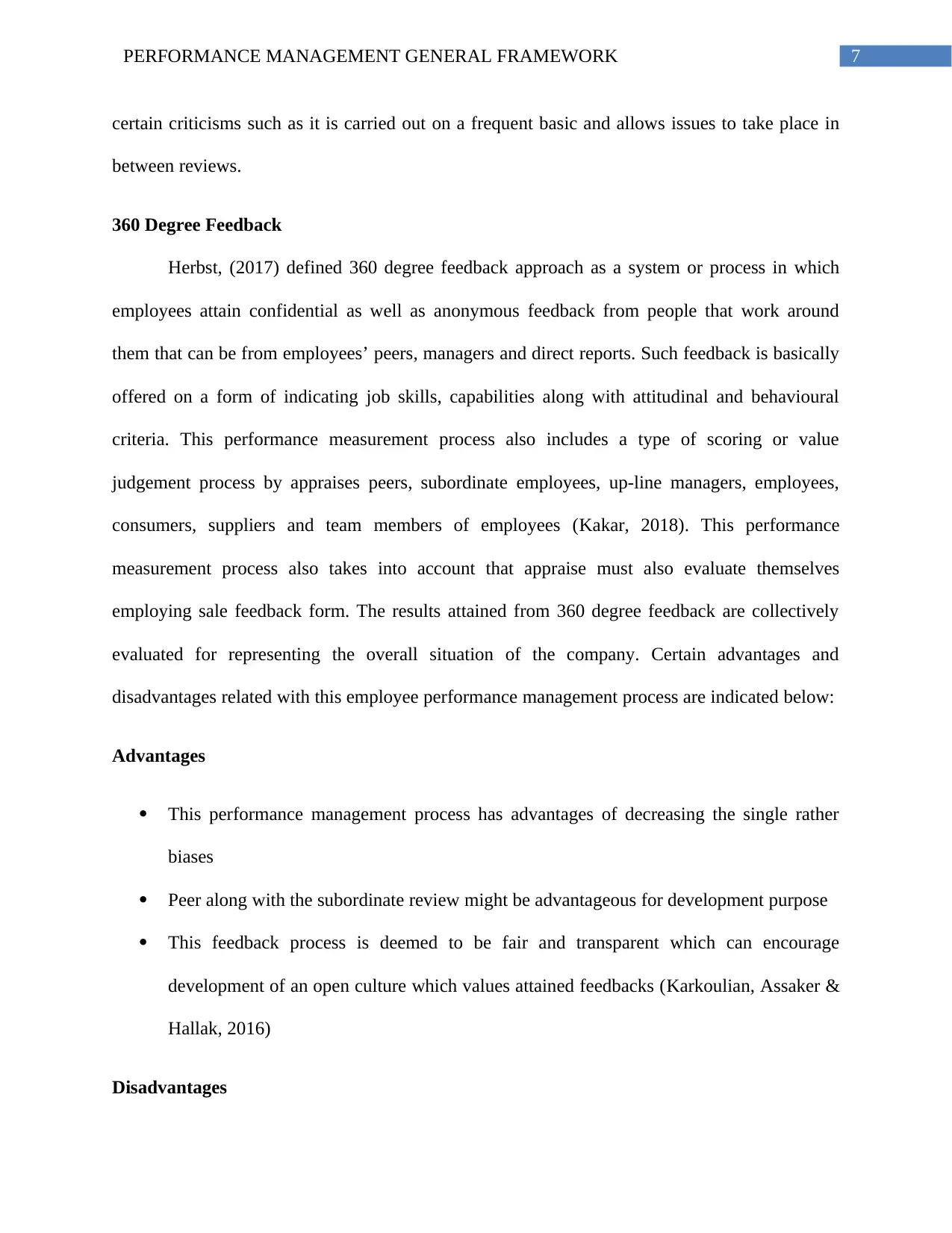
7PERFORMANCE MANAGEMENT GENERAL FRAMEWORK
certain criticisms such as it is carried out on a frequent basic and allows issues to take place in
between reviews.
360 Degree Feedback
Herbst, (2017) defined 360 degree feedback approach as a system or process in which
employees attain confidential as well as anonymous feedback from people that work around
them that can be from employees’ peers, managers and direct reports. Such feedback is basically
offered on a form of indicating job skills, capabilities along with attitudinal and behavioural
criteria. This performance measurement process also includes a type of scoring or value
judgement process by appraises peers, subordinate employees, up-line managers, employees,
consumers, suppliers and team members of employees (Kakar, 2018). This performance
measurement process also takes into account that appraise must also evaluate themselves
employing sale feedback form. The results attained from 360 degree feedback are collectively
evaluated for representing the overall situation of the company. Certain advantages and
disadvantages related with this employee performance management process are indicated below:
Advantages
This performance management process has advantages of decreasing the single rather
biases
Peer along with the subordinate review might be advantageous for development purpose
This feedback process is deemed to be fair and transparent which can encourage
development of an open culture which values attained feedbacks (Karkoulian, Assaker &
Hallak, 2016)
Disadvantages
certain criticisms such as it is carried out on a frequent basic and allows issues to take place in
between reviews.
360 Degree Feedback
Herbst, (2017) defined 360 degree feedback approach as a system or process in which
employees attain confidential as well as anonymous feedback from people that work around
them that can be from employees’ peers, managers and direct reports. Such feedback is basically
offered on a form of indicating job skills, capabilities along with attitudinal and behavioural
criteria. This performance measurement process also includes a type of scoring or value
judgement process by appraises peers, subordinate employees, up-line managers, employees,
consumers, suppliers and team members of employees (Kakar, 2018). This performance
measurement process also takes into account that appraise must also evaluate themselves
employing sale feedback form. The results attained from 360 degree feedback are collectively
evaluated for representing the overall situation of the company. Certain advantages and
disadvantages related with this employee performance management process are indicated below:
Advantages
This performance management process has advantages of decreasing the single rather
biases
Peer along with the subordinate review might be advantageous for development purpose
This feedback process is deemed to be fair and transparent which can encourage
development of an open culture which values attained feedbacks (Karkoulian, Assaker &
Hallak, 2016)
Disadvantages
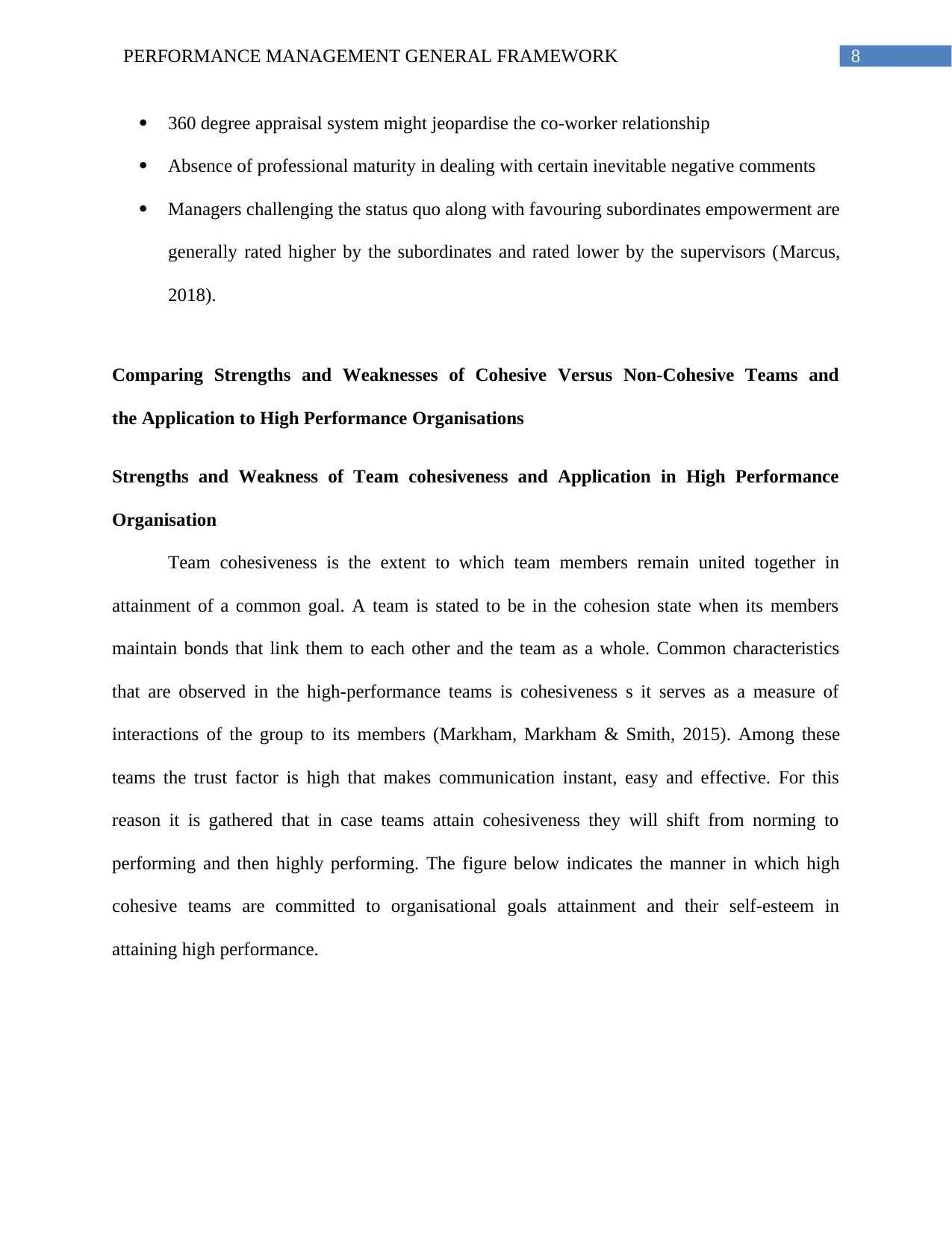
8PERFORMANCE MANAGEMENT GENERAL FRAMEWORK
360 degree appraisal system might jeopardise the co-worker relationship
Absence of professional maturity in dealing with certain inevitable negative comments
Managers challenging the status quo along with favouring subordinates empowerment are
generally rated higher by the subordinates and rated lower by the supervisors (Marcus,
2018).
Comparing Strengths and Weaknesses of Cohesive Versus Non-Cohesive Teams and
the Application to High Performance Organisations
Strengths and Weakness of Team cohesiveness and Application in High Performance
Organisation
Team cohesiveness is the extent to which team members remain united together in
attainment of a common goal. A team is stated to be in the cohesion state when its members
maintain bonds that link them to each other and the team as a whole. Common characteristics
that are observed in the high-performance teams is cohesiveness s it serves as a measure of
interactions of the group to its members (Markham, Markham & Smith, 2015). Among these
teams the trust factor is high that makes communication instant, easy and effective. For this
reason it is gathered that in case teams attain cohesiveness they will shift from norming to
performing and then highly performing. The figure below indicates the manner in which high
cohesive teams are committed to organisational goals attainment and their self-esteem in
attaining high performance.
360 degree appraisal system might jeopardise the co-worker relationship
Absence of professional maturity in dealing with certain inevitable negative comments
Managers challenging the status quo along with favouring subordinates empowerment are
generally rated higher by the subordinates and rated lower by the supervisors (Marcus,
2018).
Comparing Strengths and Weaknesses of Cohesive Versus Non-Cohesive Teams and
the Application to High Performance Organisations
Strengths and Weakness of Team cohesiveness and Application in High Performance
Organisation
Team cohesiveness is the extent to which team members remain united together in
attainment of a common goal. A team is stated to be in the cohesion state when its members
maintain bonds that link them to each other and the team as a whole. Common characteristics
that are observed in the high-performance teams is cohesiveness s it serves as a measure of
interactions of the group to its members (Markham, Markham & Smith, 2015). Among these
teams the trust factor is high that makes communication instant, easy and effective. For this
reason it is gathered that in case teams attain cohesiveness they will shift from norming to
performing and then highly performing. The figure below indicates the manner in which high
cohesive teams are committed to organisational goals attainment and their self-esteem in
attaining high performance.
⊘ This is a preview!⊘
Do you want full access?
Subscribe today to unlock all pages.

Trusted by 1+ million students worldwide
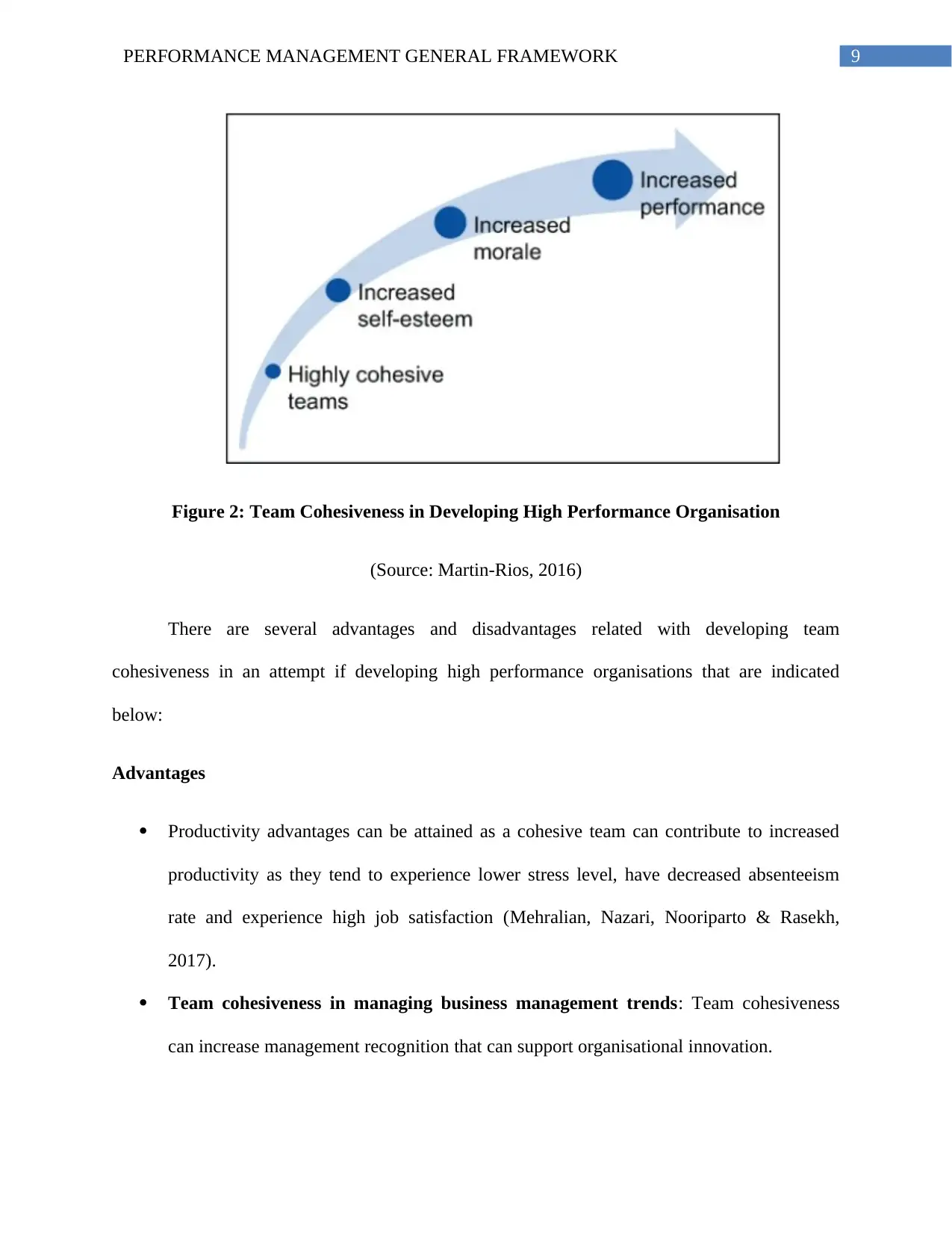
9PERFORMANCE MANAGEMENT GENERAL FRAMEWORK
Figure 2: Team Cohesiveness in Developing High Performance Organisation
(Source: Martin-Rios, 2016)
There are several advantages and disadvantages related with developing team
cohesiveness in an attempt if developing high performance organisations that are indicated
below:
Advantages
Productivity advantages can be attained as a cohesive team can contribute to increased
productivity as they tend to experience lower stress level, have decreased absenteeism
rate and experience high job satisfaction (Mehralian, Nazari, Nooriparto & Rasekh,
2017).
Team cohesiveness in managing business management trends: Team cohesiveness
can increase management recognition that can support organisational innovation.
Figure 2: Team Cohesiveness in Developing High Performance Organisation
(Source: Martin-Rios, 2016)
There are several advantages and disadvantages related with developing team
cohesiveness in an attempt if developing high performance organisations that are indicated
below:
Advantages
Productivity advantages can be attained as a cohesive team can contribute to increased
productivity as they tend to experience lower stress level, have decreased absenteeism
rate and experience high job satisfaction (Mehralian, Nazari, Nooriparto & Rasekh,
2017).
Team cohesiveness in managing business management trends: Team cohesiveness
can increase management recognition that can support organisational innovation.
Paraphrase This Document
Need a fresh take? Get an instant paraphrase of this document with our AI Paraphraser
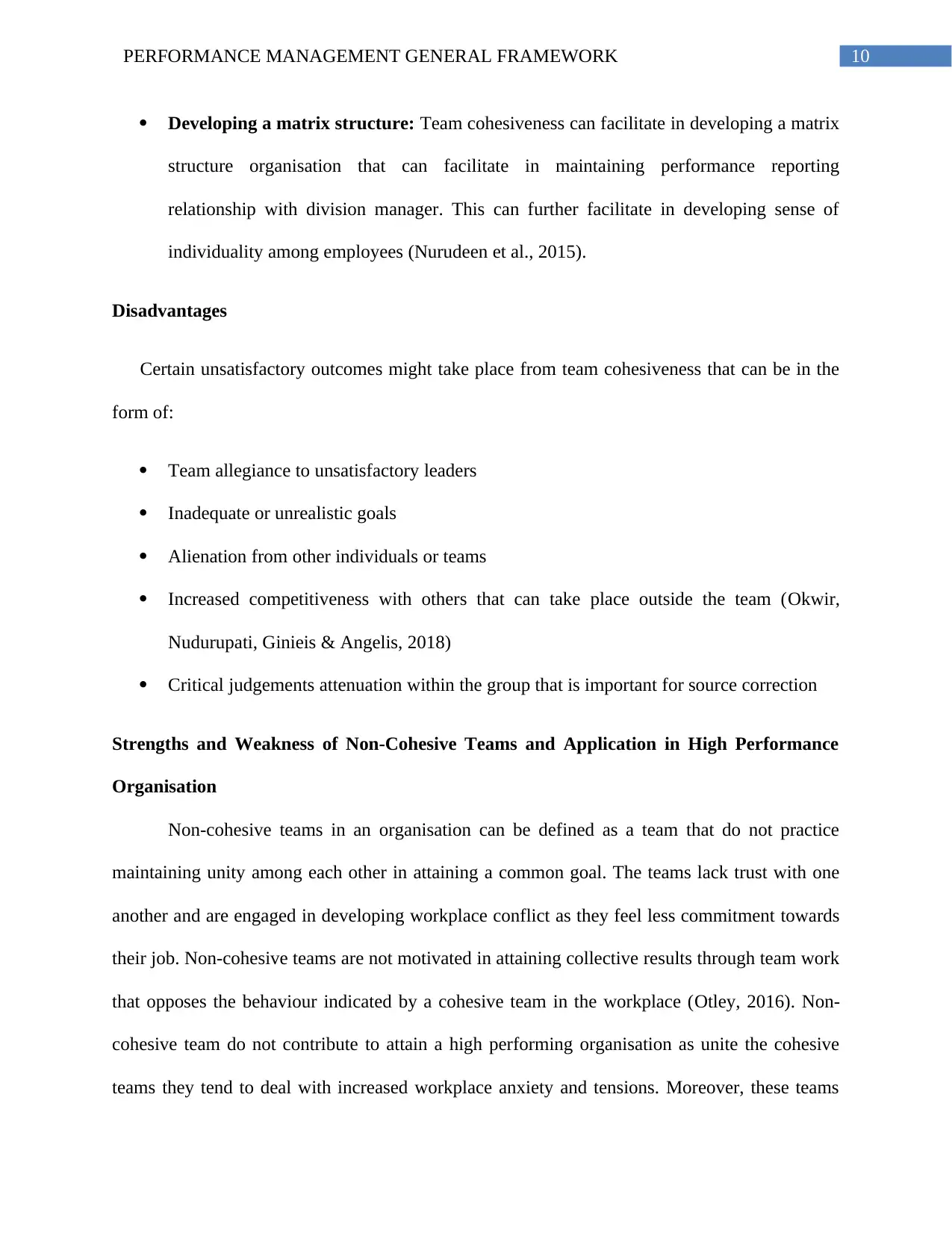
10PERFORMANCE MANAGEMENT GENERAL FRAMEWORK
Developing a matrix structure: Team cohesiveness can facilitate in developing a matrix
structure organisation that can facilitate in maintaining performance reporting
relationship with division manager. This can further facilitate in developing sense of
individuality among employees (Nurudeen et al., 2015).
Disadvantages
Certain unsatisfactory outcomes might take place from team cohesiveness that can be in the
form of:
Team allegiance to unsatisfactory leaders
Inadequate or unrealistic goals
Alienation from other individuals or teams
Increased competitiveness with others that can take place outside the team (Okwir,
Nudurupati, Ginieis & Angelis, 2018)
Critical judgements attenuation within the group that is important for source correction
Strengths and Weakness of Non-Cohesive Teams and Application in High Performance
Organisation
Non-cohesive teams in an organisation can be defined as a team that do not practice
maintaining unity among each other in attaining a common goal. The teams lack trust with one
another and are engaged in developing workplace conflict as they feel less commitment towards
their job. Non-cohesive teams are not motivated in attaining collective results through team work
that opposes the behaviour indicated by a cohesive team in the workplace (Otley, 2016). Non-
cohesive team do not contribute to attain a high performing organisation as unite the cohesive
teams they tend to deal with increased workplace anxiety and tensions. Moreover, these teams
Developing a matrix structure: Team cohesiveness can facilitate in developing a matrix
structure organisation that can facilitate in maintaining performance reporting
relationship with division manager. This can further facilitate in developing sense of
individuality among employees (Nurudeen et al., 2015).
Disadvantages
Certain unsatisfactory outcomes might take place from team cohesiveness that can be in the
form of:
Team allegiance to unsatisfactory leaders
Inadequate or unrealistic goals
Alienation from other individuals or teams
Increased competitiveness with others that can take place outside the team (Okwir,
Nudurupati, Ginieis & Angelis, 2018)
Critical judgements attenuation within the group that is important for source correction
Strengths and Weakness of Non-Cohesive Teams and Application in High Performance
Organisation
Non-cohesive teams in an organisation can be defined as a team that do not practice
maintaining unity among each other in attaining a common goal. The teams lack trust with one
another and are engaged in developing workplace conflict as they feel less commitment towards
their job. Non-cohesive teams are not motivated in attaining collective results through team work
that opposes the behaviour indicated by a cohesive team in the workplace (Otley, 2016). Non-
cohesive team do not contribute to attain a high performing organisation as unite the cohesive
teams they tend to deal with increased workplace anxiety and tensions. Moreover, these teams
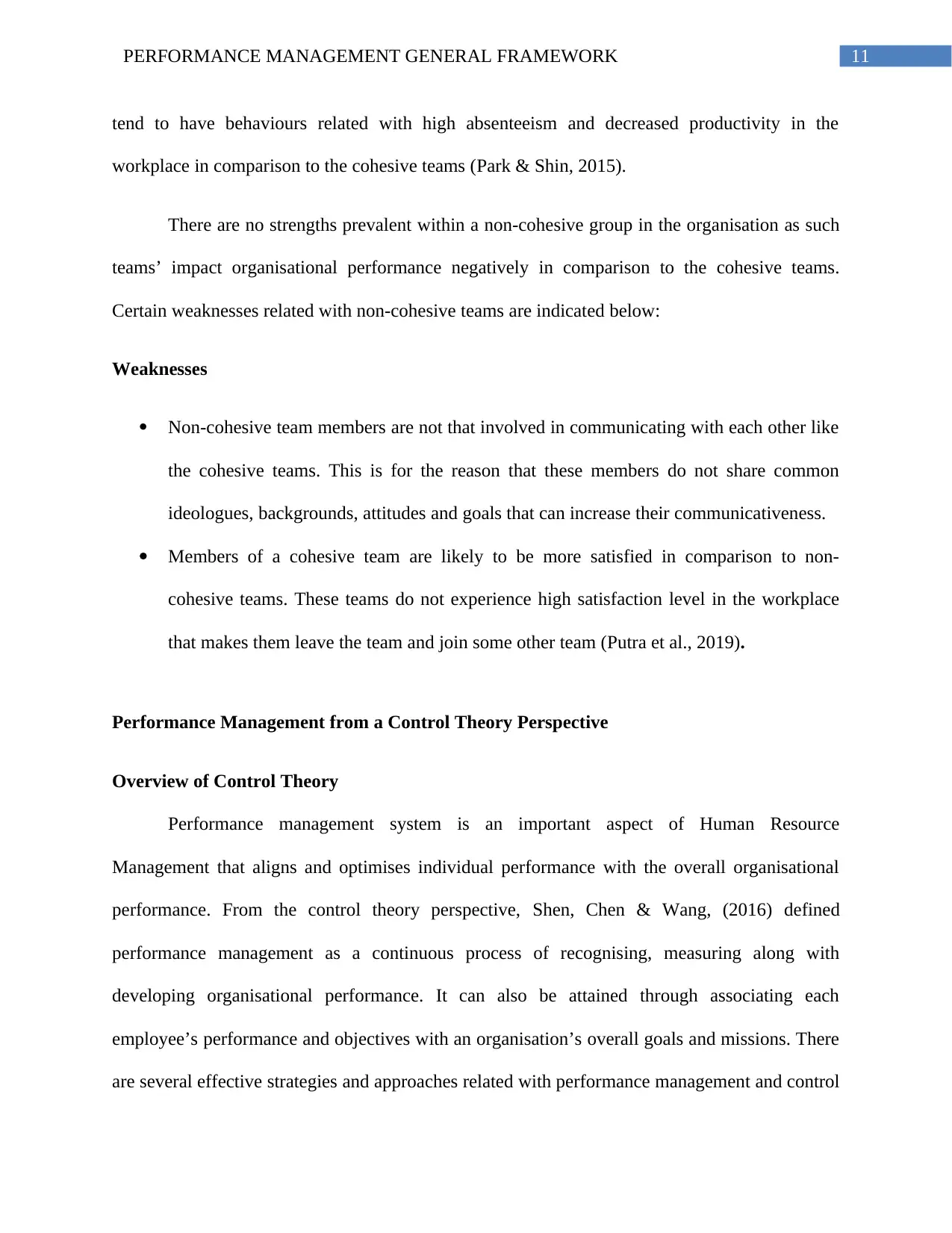
11PERFORMANCE MANAGEMENT GENERAL FRAMEWORK
tend to have behaviours related with high absenteeism and decreased productivity in the
workplace in comparison to the cohesive teams (Park & Shin, 2015).
There are no strengths prevalent within a non-cohesive group in the organisation as such
teams’ impact organisational performance negatively in comparison to the cohesive teams.
Certain weaknesses related with non-cohesive teams are indicated below:
Weaknesses
Non-cohesive team members are not that involved in communicating with each other like
the cohesive teams. This is for the reason that these members do not share common
ideologues, backgrounds, attitudes and goals that can increase their communicativeness.
Members of a cohesive team are likely to be more satisfied in comparison to non-
cohesive teams. These teams do not experience high satisfaction level in the workplace
that makes them leave the team and join some other team (Putra et al., 2019).
Performance Management from a Control Theory Perspective
Overview of Control Theory
Performance management system is an important aspect of Human Resource
Management that aligns and optimises individual performance with the overall organisational
performance. From the control theory perspective, Shen, Chen & Wang, (2016) defined
performance management as a continuous process of recognising, measuring along with
developing organisational performance. It can also be attained through associating each
employee’s performance and objectives with an organisation’s overall goals and missions. There
are several effective strategies and approaches related with performance management and control
tend to have behaviours related with high absenteeism and decreased productivity in the
workplace in comparison to the cohesive teams (Park & Shin, 2015).
There are no strengths prevalent within a non-cohesive group in the organisation as such
teams’ impact organisational performance negatively in comparison to the cohesive teams.
Certain weaknesses related with non-cohesive teams are indicated below:
Weaknesses
Non-cohesive team members are not that involved in communicating with each other like
the cohesive teams. This is for the reason that these members do not share common
ideologues, backgrounds, attitudes and goals that can increase their communicativeness.
Members of a cohesive team are likely to be more satisfied in comparison to non-
cohesive teams. These teams do not experience high satisfaction level in the workplace
that makes them leave the team and join some other team (Putra et al., 2019).
Performance Management from a Control Theory Perspective
Overview of Control Theory
Performance management system is an important aspect of Human Resource
Management that aligns and optimises individual performance with the overall organisational
performance. From the control theory perspective, Shen, Chen & Wang, (2016) defined
performance management as a continuous process of recognising, measuring along with
developing organisational performance. It can also be attained through associating each
employee’s performance and objectives with an organisation’s overall goals and missions. There
are several effective strategies and approaches related with performance management and control
⊘ This is a preview!⊘
Do you want full access?
Subscribe today to unlock all pages.

Trusted by 1+ million students worldwide
1 out of 37
Related Documents
Your All-in-One AI-Powered Toolkit for Academic Success.
+13062052269
info@desklib.com
Available 24*7 on WhatsApp / Email
![[object Object]](/_next/static/media/star-bottom.7253800d.svg)
Unlock your academic potential
Copyright © 2020–2025 A2Z Services. All Rights Reserved. Developed and managed by ZUCOL.





